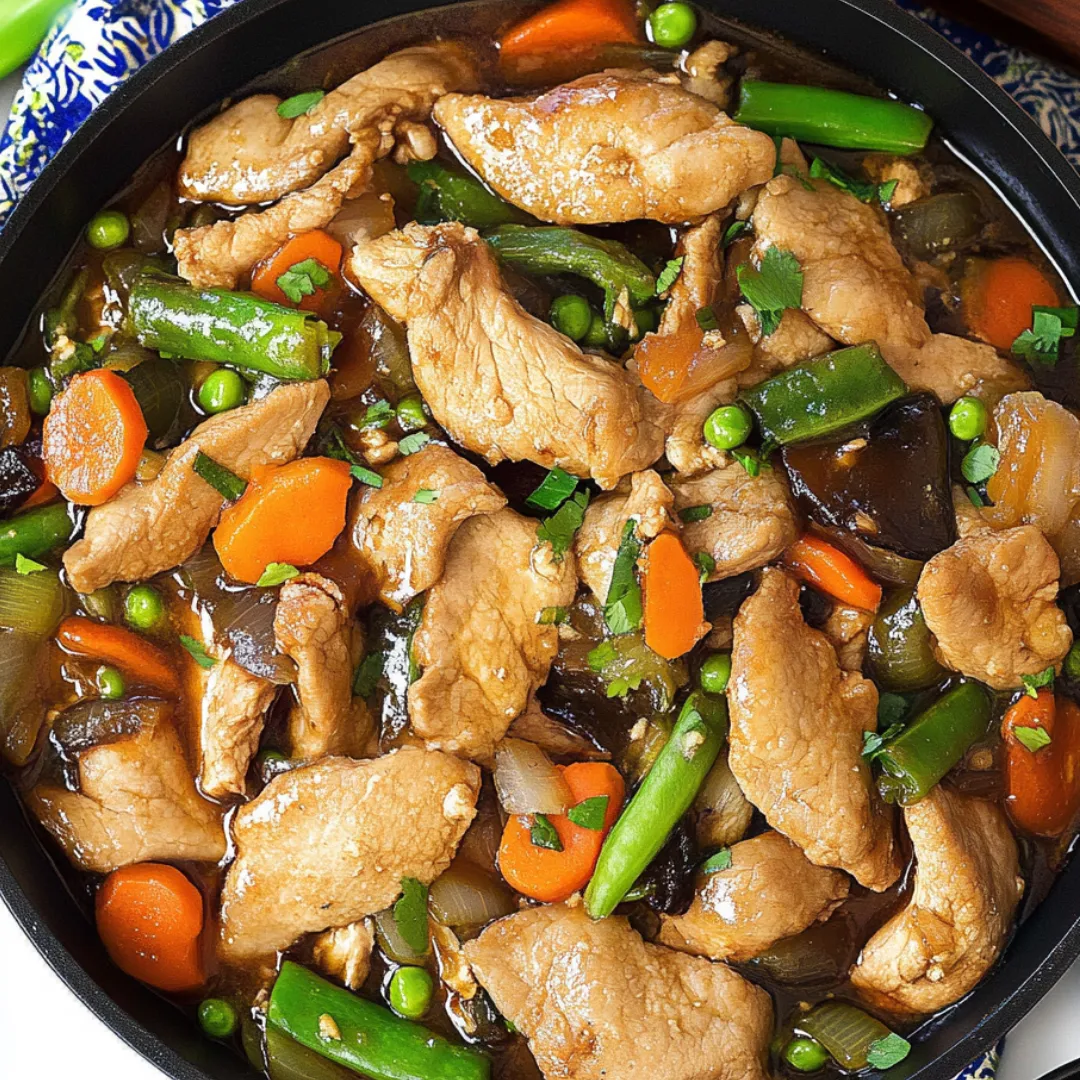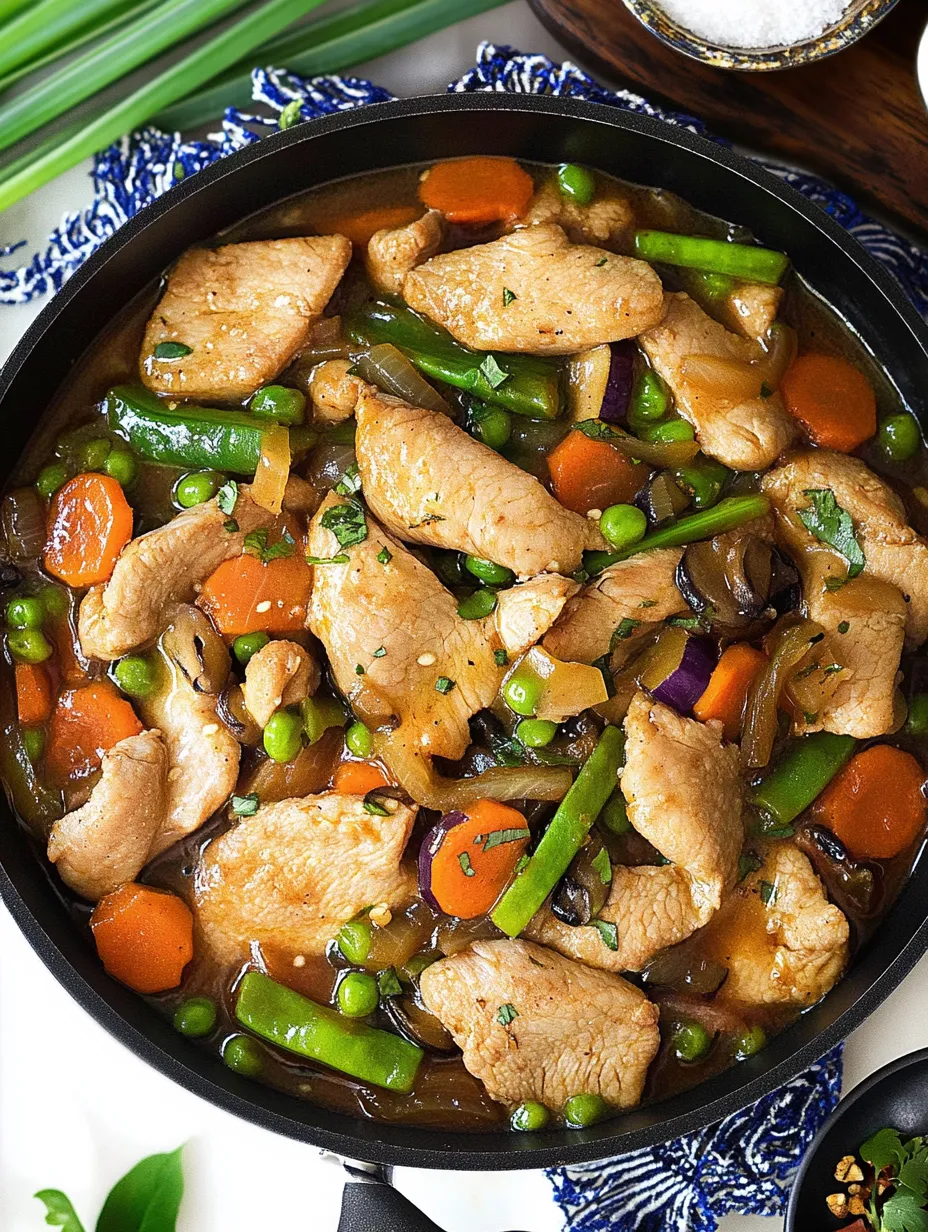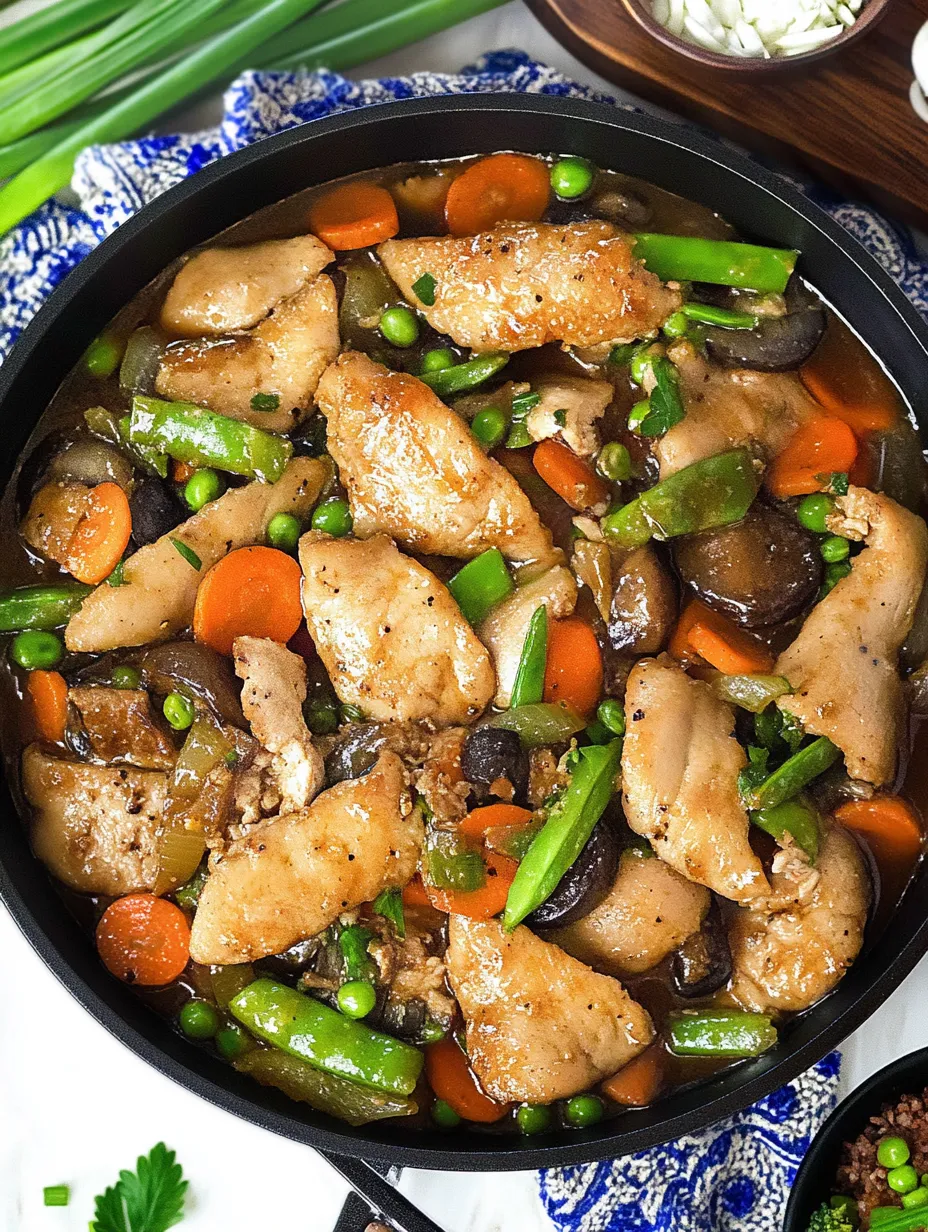 Pin it
Pin it
Moo Goo Gai Pan celebrates the elegant simplicity of Cantonese cooking with its perfect balance of tender chicken, crisp vegetables, and a light, savory sauce that lets each ingredient shine. This beloved dish—whose name translates to 'mushroom chicken slices'—epitomizes the essence of Chinese stir-frying: quick cooking that preserves the natural flavors and textures of fresh ingredients. Unlike many Americanized Chinese dishes with heavy, cloying sauces, authentic Moo Goo Gai Pan relies on the intrinsic qualities of its components, enhanced by a delicate sauce that complements rather than overwhelms. The result is a harmonious meal that's simultaneously satisfying and light, perfect for both special occasions and everyday dinners.
My grandmother taught me to make Moo Goo Gai Pan when I was barely tall enough to see over the counter. She'd place a wooden stool beside her at the stove and let me watch as she transformed simple ingredients into something magical. 'The secret,' she would say while deftly manipulating her well-seasoned wok, 'is timing each ingredient just right.' Years later, when I made this dish for my own family during a particularly chaotic weeknight, my daughter had the same wide-eyed wonder watching the vegetables dance around the pan. This recipe has become our Tuesday night tradition—a reminder that a truly satisfying meal doesn't require complicated techniques or exotic ingredients.
Ingredients You'll Need
- 1 pound chicken breasts: Slice thinly against the grain for the most tender results; partially freezing the meat for 20 minutes makes this easier
- 3 tablespoons cornstarch (divided): The secret to velvety-textured chicken and a silky sauce; don't substitute with flour as the results won't be the same
- 1 teaspoon kosher salt: Diamond Crystal kosher salt has larger crystals than table salt, so adjust accordingly if using a different type
- ½ teaspoon ground white pepper: Provides subtle heat without the visual black flecks of black pepper; an authentic touch worth seeking out
- 3 tablespoons vegetable oil (divided): Choose a neutral oil with a high smoke point; peanut oil is traditional but any neutral oil works well
- 1 medium carrot: Adds color, sweetness, and texture; slice on the diagonal for maximum visual appeal and even cooking
- 6 ounces snow peas: These provide vibrant color and delightful crunch; string them before cooking for the best eating experience
- 6 ounces mushrooms: Traditional recipes use Chinese black mushrooms (shiitake), but white button or cremini work beautifully too
- 8 ounces water chestnuts: These add an essential textural element with their distinctive crunch; rinse well to remove any tinny flavor
- 8 ounces bamboo shoots: Another traditional addition that provides unique texture and subtle flavor; again, rinse thoroughly before using
- 3 cloves garlic: Fresh garlic is non-negotiable; its aromatic foundation transforms the dish
- 1¼ cups chicken stock: Homemade provides the best flavor, but a good-quality low-sodium store-bought version works well
- 2 tablespoons soy sauce: Use light soy sauce for a cleaner flavor that won't overwhelm the delicate vegetables
- 1 teaspoon granulated sugar: Just enough to balance the flavors without making the dish sweet
- 1 teaspoon toasted sesame oil: Add this at the end of cooking to preserve its aromatic qualities; a little goes a long way
 Pin it
Pin it
Step-by-Step Cooking Instructions
- Prepare the Chicken Using the Velveting Technique:
- Place your thinly sliced chicken in a medium bowl and sprinkle with 2 tablespoons of cornstarch, salt, and white pepper. Use your fingers to gently toss the chicken, ensuring each piece is evenly coated. Add 1 tablespoon of vegetable oil and mix again, making sure the pieces are separated and not clumping together. This coating creates a protective barrier that seals in moisture during the high-heat cooking process, resulting in incredibly tender meat. Let the chicken rest for 10-15 minutes while you prepare the other ingredients – this resting time allows the coating to adhere properly.
- Prepare Your Mise En Place:
- Before heating your wok, have all ingredients prepared and arranged in the order they'll be cooked. Slice your carrot on a diagonal into thin, uniform pieces. Trim the ends of your snow peas and remove the strings if necessary. Clean and slice your mushrooms, ensuring they're dry (wet mushrooms will steam rather than stir-fry). Drain and rinse the water chestnuts and bamboo shoots thoroughly. Mince your garlic. In a small bowl, whisk together the chicken stock, soy sauce, sugar, and sesame oil. In another small bowl, create a slurry by mixing the remaining 1 tablespoon of cornstarch with 1 tablespoon of cold water until smooth. Having everything ready before you start cooking is essential for a successful stir-fry, as the process moves quickly.
- Cook the Chicken to Perfection:
- Heat a wok or large skillet over high heat until a drop of water evaporates within 1-2 seconds of contact. Add 2 tablespoons of vegetable oil and swirl to coat the cooking surface. When the oil is shimmering but not smoking, carefully add the marinated chicken pieces in a single layer. Let them cook undisturbed for 30 seconds to develop a slight sear, then stir-fry for another 30-60 seconds until the exterior is opaque but the chicken is not yet fully cooked through. Transfer to a clean plate and set aside. The chicken will finish cooking when returned to the wok later, preventing it from becoming tough and overcooked.
- Stir-Fry the Vegetables in Sequence:
- Return the wok to high heat. If it looks dry, add the remaining tablespoon of oil. Add the carrots first, as they take the longest to cook, and stir-fry for 1-2 minutes until they begin to soften slightly. Add the snow peas and mushrooms next, tossing continuously for about 2 minutes until the mushrooms begin to release their moisture and the snow peas turn bright green. Finally, add the water chestnuts, bamboo shoots, and minced garlic. Stir-fry for another 30-60 seconds, just until the garlic becomes fragrant. The sequential addition of vegetables ensures each is cooked to the perfect doneness – crisp-tender rather than mushy.
- Combine and Create the Sauce:
- Return the partially cooked chicken to the wok, along with any accumulated juices. Pour in your prepared sauce mixture of chicken stock, soy sauce, sugar, and sesame oil. Bring everything to a gentle boil, stirring occasionally to combine the flavors. Let it simmer for about 1-2 minutes, allowing the chicken to finish cooking through. Give your cornstarch slurry a quick stir (it settles quickly) and drizzle it into the wok while stirring constantly. Continue cooking and stirring until the sauce thickens enough to coat the back of a spoon, about 30-60 seconds. The cornstarch not only thickens the sauce but gives it a beautiful glossy appearance characteristic of Chinese restaurant dishes.
- Taste and Adjust Before Serving:
- Remove the wok from heat and taste a small spoonful of the sauce. This is your opportunity to make final adjustments – a pinch more sugar if it needs sweetness, a dash more soy sauce for saltiness, or even a few drops of sesame oil for more aromatic depth. Transfer everything to a large serving platter or individual plates alongside steamed rice. Garnish with thinly sliced green onions or toasted sesame seeds if desired. Serve immediately while hot, as the texture and flavors are at their peak straight from the wok.
My first attempts at making Moo Goo Gai Pan resulted in either mushy vegetables or tough, dry chicken—until I learned the importance of timing. I remember calling my grandmother in frustration after another disappointing dinner, and she laughed sympathetically before explaining that stir-frying is as much about when you add each ingredient as how you cook it. 'Think of your wok as a stage,' she told me, 'where each ingredient makes its entrance at the perfect moment.' That advice transformed my approach, and now the rhythmic dance of adding components at just the right time feels almost meditative, a skill I've refined over countless weeknight dinners.
The Origins Beyond the Name
The name 'Moo Goo Gai Pan' comes from Cantonese: 'moo goo' refers to mushrooms, 'gai' means chicken, and 'pan' signifies slices. While the dish has evolved since arriving in America—becoming sweeter and incorporating a wider variety of vegetables—its essential character remains rooted in Cantonese cooking philosophy: fresh ingredients, minimal seasoning, and quick cooking to preserve natural flavors. Traditional versions in Hong Kong and Guangdong might use only chicken, mushrooms, and perhaps bamboo shoots, focusing on the quality of these few ingredients rather than creating a medley. Understanding this origin helps explain why balance and restraint are so central to authentic versions of the dish.
Customizing For Dietary Needs
This versatile recipe adapts beautifully to various dietary requirements. For a gluten-free version, simply substitute tamari for soy sauce and verify your chicken stock is gluten-free. Those following paleo or Whole30 diets can thicken the sauce with arrowroot powder instead of cornstarch and use coconut aminos in place of soy sauce. Vegetarians can replace the chicken with firm tofu (press it well and proceed with the same velveting technique) or tempeh, while vegans can also swap the chicken stock for vegetable broth. For those watching carbohydrates, serve over cauliflower rice instead of traditional steamed rice—the sauce works beautifully with either option.
Seasonal Vegetable Variations
One of this dish's greatest strengths is its adaptability to seasonal produce. Spring versions might incorporate tender asparagus tips and fresh peas. Summer calls for zucchini ribbons and bell peppers at their peak sweetness. Fall editions can include firm-fleshed winter squash cut into thin slices that cook quickly. Even winter offers options with hardy vegetables like thinly sliced Brussels sprouts or quick-cooking cabbage adding variety. This flexibility makes Moo Goo Gai Pan a year-round staple that never becomes monotonous. The constants—the velveted chicken, the balanced sauce, the quick cooking method—provide a reliable framework for creative seasonal interpretations.
 Pin it
Pin it
Make-Ahead Strategies for Busy Nights
On particularly hectic days, prep components in advance to make dinner assembly nearly effortless. The chicken can be sliced, velveted, and refrigerated (covered) for up to 24 hours before cooking. All vegetables can be cleaned, chopped, and stored in the refrigerator up to a day ahead. The sauce ingredients can be combined and refrigerated, as can the cornstarch slurry (though it may need re-whisking before use). With these elements prepared, the actual cooking process takes less than 10 minutes—quicker than ordering takeout and infinitely more satisfying. This approach has saved countless weeknight dinners in my household, especially during busy school seasons.
The magic of Moo Goo Gai Pan lies not in exotic ingredients or complicated techniques, but in understanding the foundational principles of great stir-frying: respecting each ingredient's cooking time, maintaining high heat, and creating a sauce that enhances rather than masks natural flavors. Every time I prepare this dish, I'm reminded of my grandmother's patient lessons at the stove—how she emphasized these fundamentals rather than rigid recipes. This approach has made Moo Goo Gai Pan not just a dinner option but a cooking philosophy I return to whenever I need a meal that balances nutrition, flavor, and efficiency. In a world of complicated food trends, there's something deeply satisfying about mastering this timeless classic.
Frequently Asked Questions
- → What does Moo Goo Gai Pan mean?
- Moo Goo Gai Pan translates to 'mushroom chicken slices' in Cantonese. 'Moo goo' refers to mushrooms, 'gai' means chicken, and 'pan' means slices, describing the key ingredients and preparation style.
- → Can I make this dish ahead of time?
- While best enjoyed fresh, you can prepare all ingredients ahead of time and store separately. The completed dish can be refrigerated for up to 2 days, though vegetables may lose some crispness when reheated.
- → What type of mushrooms work best?
- Traditional recipes use white button or cremini mushrooms, but shiitake, oyster, or any mushroom variety works well. Each brings a different flavor profile, so feel free to experiment.
- → Is Moo Goo Gai Pan healthy?
- Yes, it's one of the healthier Chinese dishes. It's loaded with vegetables, lean protein, and uses minimal oil compared to deep-fried dishes. The sauce is light and relatively low in sodium.
- → What can I substitute for water chestnuts or bamboo shoots?
- If unavailable, jicama or celery can replace water chestnuts for crunch. For bamboo shoots, try bean sprouts, sliced hearts of palm, or extra vegetables like broccoli or zucchini.
